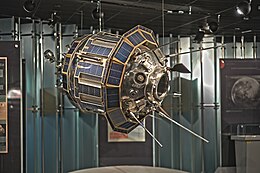 A 1:1 scale model at the Memorial Museum of Cosmonautics in Moscow | |
| Mission type | Lunar flyby[1] |
|---|---|
| Operator | Soviet space program |
| Harvard designation | 1959 Theta 1[2] |
| COSPAR ID | 1959-008A |
| SATCAT no. | 21 |
| Mission duration | 18 days (launch day to last contact day) |
| Orbits completed | 14 |
| Spacecraft properties | |
| Spacecraft | Ye-2A No.1[1] |
| Manufacturer | OKB-1 |
| Launch mass | 278.5 kilograms (614 lb)[1] |
| Start of mission | |
| Launch date | 4 October 1959, 00:43:40 UTC[1] |
| Rocket | Luna 8K72 (No I1-8)[1] |
| Launch site | Baikonur 1/5[1] |
| End of mission | |
| Last contact | 22 October 1959[3] |
| Decay date | 29 April 1960 |
| Orbital parameters | |
| Reference system | Geocentric |
| Regime | Highly elliptical (circumlunar) |
| Semi-major axis | 256,620.50 kilometres (159,456.59 mi) |
| Eccentricity | 0.97322501 |
| Perigee altitude | 500 kilometres (310 mi) |
| Apogee altitude | 499,999 kilometres (310,685 mi) |
| Inclination | 55 degrees |
| Period | 359.38 hours |
| Epoch | 5 October 1959[4] |
| Flyby of the Moon | |
| Closest approach | 6 October 1959, 14:16 UTC |
| Distance | 6,200 kilometres (3,900 mi) |
Luna 3, or E-2A No.1 (Russian: Луна 3), was a Soviet spacecraft launched in 1959 as part of the Luna programme. It was the first mission to photograph the far side of the Moon and the third Soviet space probe to be sent to the neighborhood of the Moon.[5] The historic, never-before-seen views of the far side of the Moon caused excitement and interest when they were published around the world, and a tentative Atlas of the Far Side of the Moon was created from the pictures.
These views showed mountainous terrain, very different from the near side, and only two dark, low-lying regions, which were named Mare Moscoviense (Sea of Moscow) and Mare Desiderii (Sea of Desire). Mare Desiderii was later found to be composed of a smaller mare, Mare Ingenii (Sea of Cleverness), and several other dark craters. The reason for this difference between the two sides of the Moon is still not fully understood, but it seems that most of the dark lavas that flowed out to produce the maria formed under the Earth-facing half.[6]
- ^ a b c d e f Siddiqi 2018, p. 13.
- ^ "Luna Ye-2A". Gunter's Space Page. Retrieved 12 November 2019.
- ^ "Luna 3". NASA Space Science Data Coordinated Archive. Retrieved 5 February 2020.
- ^ McDowell, Jonathan. "Satellite Catalog". Jonathan's Space Page. Retrieved 14 December 2014.
- ^ Harvey 2011, p. 158.
- ^ "Exploring the Moon – The first robot explorers". Ianridpath.com. Retrieved 6 November 2013.